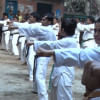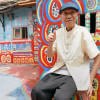Fifty years on, Bruce Lee’s legacy squares up to modern life in Hong Kong

Fifty years after the death of Bruce Lee, who galvanised the imaginations of generations of young people worldwide with feats of kung fu immortalised on screen, it sometimes seems as if his legacy of the martial art he practiced is fading in Hong Kong.
Born in San Francisco but brought up in the Asian financial hub which would make him famous, Lee died of brain edema aged 32 on July 20, 1973, just six days before the release of "Enter the Dragon", his most popular film.
"He was exceptionally talented and it's a shame he passed away at such a young age," said 60-year-old Dorothy Tam, whose hair is now graying, as she punched a sandbag in a small martial arts school covered with bamboo scaffolding in western Kowloon.
Captivated by the skill displayed in Lee's performance, Tam, who was just 10 at the time, became a lifelong admirer.
But only in 2019 did Tam overcome her initial apprehension towards Hong Kong's male-dominated martial arts scene to start learning Wing Chun, the southern Chinese style of the martial art in which Lee had trained.
"I discovered it's actually a martial art suitable for women as well, emphasizing softness to overcome hardness," said Tam, as she stood beside a bronze bust of Lee's teacher, the late grandmaster Ip Man.
She began learning with her godson, but her classmates come from all walks of life, some working in information technology and others in business consulting. Most train at night, some still in their office wear.
"Martial arts are not solely about fighting," Tam added. "My instructor often emphasises that self-defense is about avoiding conflict and focusing on self-improvement."
Lee's contributions to martial arts, film, and philosophy have inspired legions of global fans but the legacy that endured for half a century is sometimes seen as a relic of the past in the former British colony.

 For all latest news, follow The Daily Star's Google News channel.
For all latest news, follow The Daily Star's Google News channel. 








Comments